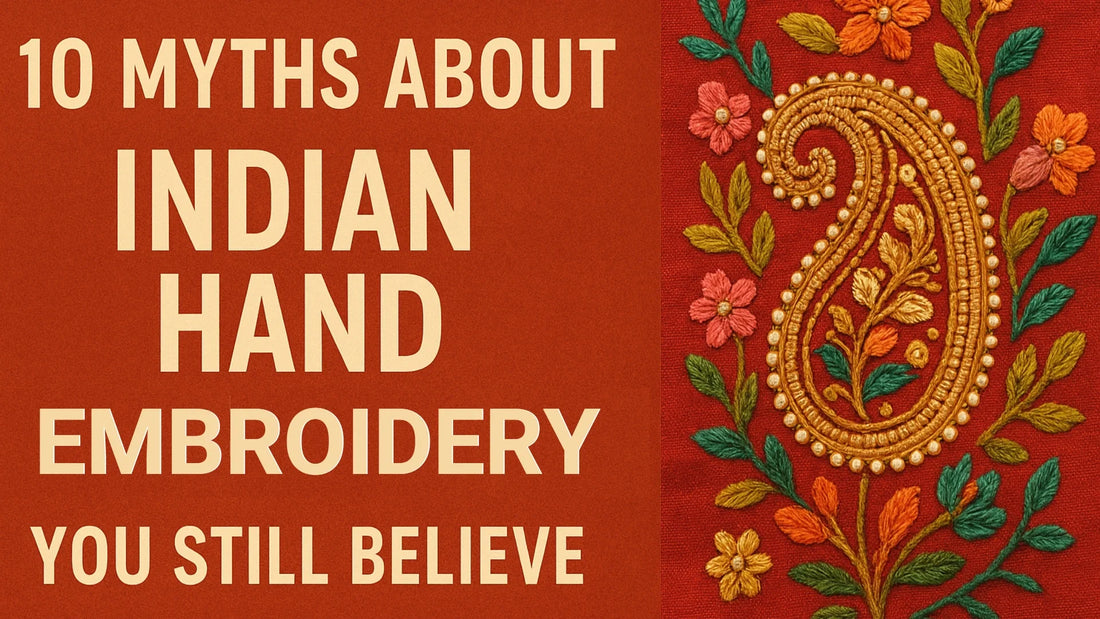
10 Myths About Indian Hand Embroidery You Still Believe
Share
Introduction
India’s hand embroidery is more than just design — it’s a language of heritage, skill, and stories stitched over centuries. Yet, despite its cultural richness, hand embroidery is often misunderstood. Misinformation, fast fashion, and mass production have buried the truth under layers of myths.
Let’s unravel the 10 most common myths about Indian hand embroidery that many still believe — and why it’s time to let them go.
Myth 1: All Embroidery Is Done by Machines Now
Reality:
While machines can replicate patterns, true Indian embroidery is still done by hand in many artisanal hubs. Styles like Chikankari, Kantha, and Zardozi are traditionally hand-stitched — each piece taking hours, sometimes weeks, to complete. Machine embroidery may copy the look, but it can never match the soul of handcrafted art.
Myth 2: Embroidery Is Just Decoration — It Has No Meaning
Reality:
Traditional Indian embroidery is deeply symbolic. For example, Chikankari motifs often represent natural elements — peacocks, vines, lotuses — all carrying cultural and spiritual meaning. In Gujarat’s Rabari embroidery, stitches tell personal stories, dowry histories, or tribal folklore.
Myth 3: White Thread Work Is Just for Old People
Reality:
White-on-white embroidery like Chikankari is timeless, not outdated. It’s being reimagined by Gen Z stylists and slow-fashion brands alike — think Chikankari paired with denim jackets, crop tops, and even sneakers. At Shwet Artistry, we call it Heritage with Attitude.
Myth 4: Handmade Means Expensive and Overpriced
Reality:
Yes, hand embroidery costs more than factory-made pieces — but for good reason. You’re paying for hours of manual craftsmanship, not just fabric. Plus, you’re supporting rural artisans and preserving a dying art. In the long run, handmade garments often outlast their cheaper, mass-produced counterparts.
Myth 5: Embroidered Clothes Are Only for Weddings or Festivals

Reality:
Many believe that embroidery belongs only in bridal wear or festive sarees. But modern Indian embroidery is evolving. From linen shirts to cotton co-ords, handcrafted embroidery is now part of everyday wear. It’s soft, breathable, and works perfectly for minimal fashion lovers.
Myth 6: If It Looks the Same, It’s the Same
Reality:
Mass-produced embroidery may look similar from afar — but look closer. The depth, finesse, and imperfection of hand embroidery are its proof of authenticity. Handmade pieces have a human touch that machines can’t fake — each slightly different, each beautifully unique.
Myth 7: Hand Embroidered Garments Are Too Delicate to Use
Reality:
This is only true if you treat them poorly. With proper care (gentle hand washing, air drying), your hand-embroidered garments can last decades. Many heirloom sarees and kurtas passed down generations are still worn today.
Myth 8: Embroidery Is a Hobby, Not a Profession
Reality:
For thousands of artisans across India — especially women — embroidery is a livelihood, not a pastime. It offers economic freedom, dignity, and a sustainable career. Supporting hand embroidery means investing in real people and real futures.

Myth 9: Indian Embroidery Isn’t Sustainable
Reality:
Hand embroidery is the epitome of slow fashion. No electricity, no carbon-heavy machines — just needle, thread, and human skill. Many artisan collectives now use natural dyes, upcycled fabrics, and organic threads to make the process even more eco-friendly.
Myth 10: It’s Hard to Tell What’s Truly Handmade
Reality:
It’s easier than you think. Look for subtle imperfections — no two handmade motifs will ever be identical. Ask about the artisan behind the piece. Brands like Shwet Artistry proudly share the origin and process behind each design, giving you transparency and trust.
Final Thread: Why It Matters
Unlearning these myths isn’t just about fashion — it’s about respecting culture, craft, and community. Every time you choose handcrafted over mass-produced, you empower real people, honor traditions, and keep centuries-old art alive.
At Shwet Artistry, we don’t just sell clothes — we carry forward legacies. The next time you wear that embroidered kurta or saree, remember: it’s not just thread. It’s history, stitched by hand.
Loved this post?
Explore our exclusive hand-embroidered collection at shwetartistry.com
Save this for later or share with someone who still believes these myths!

